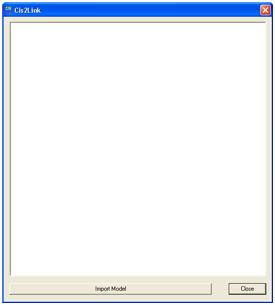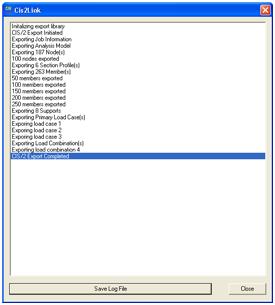AD.2007-04.0.2 CIS/2 Update
The STAAD.Pro tool to import and export models with the CIS/2 translator has been enhanced to work with international models and transferring models into 3D modeling such as SmartPlant 3D.
The CIS/2 (CimSteel Integration Standard, Version 2) allows for the transfer of steel models using a prescribed data standard in the STEP (Part 21) format. These files can contain different models including analysis models. The STAAD.Pro CIS/2 translator only operates on the analysis model within the file. While STAAD.Pro has supported a wide range of the steel sections that this standard can support, this enhancement allows a far greater range of sections to be imported/exported with this tool.
Import
The CIS/2 import can be initiated after starting a new model and before creating any model data, selecting the menu option,

Selecting the CIS/2 option and clicking on the "Import" button allows selection of a suitable STEP file. This file is a text file and will be similar to the following extract:
ISO-10303-21;
HEADER;
/* Generated by software containing ST-Developer
* from STEP Tools, Inc. (www.steptools.com)
*/
FILE_DESCRIPTION(
/* description */ ('CIS2 Export File'),
/* implementation_level */ '2;1');
FILE_NAME(
/* name */ 'model',
/* time_stamp */ '2007-01-08T17:00:33+00:00',
/* author */ (''),
/* organization */ (''),
/* preprocessor_version */ 'ST-DEVELOPER v9',
/* originating_system */ 'STAAD.Pro 2007',
/* authorisation */ '');
FILE_SCHEMA (('STRUCTURAL_FRAME_SCHEMA'));
ENDSEC;
DATA;
#10=LOAD_COMBINATION_OCCURRENCE(1.39999997615814,#13,#264);
#11=LOAD_COMBINATION_OCCURRENCE(1.39999997615814,#13,#265);
#12=LOAD_COMBINATION_OCCURRENCE(1.60000002384186,#13,#266);
#13=LOADING_COMBINATION('ULS',$,#2511);
#14=LOAD_ELEMENT_DISTRIBUTED_CURVE_LINE(#265,'Member19UDLLoad1',$,#1089,
$,$,.F.,.GLOBAL_LOAD.,.TRUE_LENGTH.,#214,#214,#64);
#15=LOAD_ELEMENT_DISTRIBUTED_CURVE_LINE(#265,'Member20UDLLoad1',$,#1090,
Once a file has been selected, the data is ready to be imported with the CIS/2 import tool thus:

Clicking the Import button then runs the model import where the CIS/2 file is processed and the analysis model data is extracted to form the STAAD.Pro model.

Note that as the CIS/2 file is being processed, a log file which identifies the data that has been utilized in the STAAD model is produced and displayed which can be saved as a text file for future reference.
Export
The CIS/2 Export is available for any model that has been created as an option in the menu item File>Export…

Selecting the CIS/2 option and clicking on the "Export" button allows the definition of a suitable STEP filename and folder to locate it. Once again the CIS/2 tool is presented, this time with an Export Model button at the bottom which when clicked creates the STP file.

Once again, when the export has completed, the user can save the log file which is produced as the model is converted into the STEP format.

Enhancements
The STAAD.Pro CIS/2 import now recognizes sections defined from standard databases such as those defined in Japanese, British, Indian, Australian and European tables.
The import/export has been enhanced to support the ability of STAAD.Pro to create double sections, such as back to back angles and channels or double wide flange sections. Additionally, it now supports the creation of T sections which are defined in STAAD.Pro as a wide flange section that is split at mid height.
Although CIS/2 has been developed for the processing of steel models, the STAAD.Pro translator will now support the transfer of prismatic properties normally associated with concrete sections. This means that sections defined as PRISMATIC in a STAAD.Pro model will be included in exported STP file and can be imported if they exist.
